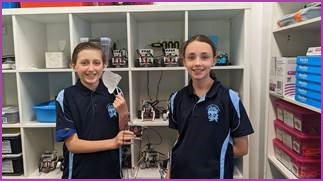Medibot 2.0, a pill reminder system based on voice recognition technology, developed by Sol Crisp from West Pymble Public School in NSW, has been recognised with a Young ICT Explorers award for the Year 3-4 age group.
It’s one of five winning inventions across different age groups in the competition that encourages students to apply creativity and innovation to tackle real-world problems through technology.
Created by SAP and supported by CSIRO Digital Careers and The Smith Family, together with the help of industry and university partners in Australia, the goal is to inspire school students of all technical ability levels to gain a greater understanding of the diverse possibilities available to them through today’s technology.
A science fair for tech
The Young Explorers competition is like a science fair, but for technology and innovation, and this year 31 finalist teams pitched their projects virtually to an industry judging panel.
Applicants are sorted by age divisions: Year 3-4, Year 5-6, Year 7-8, Year 9-10, and Year 11-12.
Projects are marked on four main criteria – creativity and innovation, project difficulty, quality and completeness and how they presented and documented their work.
The other winners include Stretchy 365, created by Lucinda Coyle and Lincoln Rucker from St Joseph's Bardon (Year 5-6 division), which is a pocket-size computer that detects the tension in a stretch sensor to indicate if a potential asthma attack could be coming on.
A bushfire recovery AI drone, called BRAID, created in a team effort by Chengyun Xu, Nabhanya Gupta, Vinay Raghavan and Sanjay Parappat from Victoria, was also given a gong (Year 7-8).
It analyses acreage and provides telemetry on what it has observed, for harvesting and examining land for water or dried leaf patches.
The Giraffe Walker, developed by Rebecca Paratz from Bailik College in Victoria, was also awarded for developing a self-levelling, intelligent, all-terrain walker that allows the elderly to safely travel up and down stairs and traverse uneven surfaces (Year 9-10).
SatAlight, developed by Dong Duong Nguyen from St Andrew's Cathedral School in NSW, was another winner. It is an AI system built to rapidly assess the bush fire proneness of land areas using satellite imagery to accurately classify vegetation based on its bushfire risk (Year 11-12).
Encouraging kids to pursue a career in STEM
The Young Explorers competition compliments the school digital technologies curriculum, with almost any technology-based projects eligible to enter.
The competition is also designed to encourage primary and high school students to consider future study and a career in tech.
Projects can be anything created in class time, or students can enter extracurricular projects they have worked on.
To get students excited about working with technology, they’re inspired to use their imagination and interest in the world around them to create projects.
Working independently or in teams of up to four, 723 students from 76 schools across the country this year submitted technology-based projects that solve a real-world problem – creating a better way to recycle, supporting the community’s most vulnerable, and emergency and crisis preparedness.
Some of the other inventions included using technology to support people with disability, creating virtual reality worlds, building entire operating systems, and robots from the future.
SAP also has an existing partnership with The Smith Family to help narrow the digital divide through SAP’s Young ICT Explorers Accelerator Program, providing resources to schools in low socio-economic communities to help prepare more young Australians for the digital careers of the future.
This year, a record 30 per cent of participants in the Young ICT Explorers competition came from The Smith Family partner schools.










